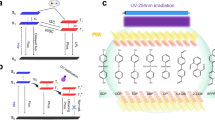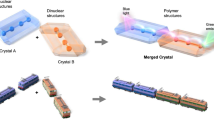Abstract
In aqueous solutions the response of polymers and biological matter to external conditions, such as temperature and pH, is typically based on the hydrophobic/hydrophilic balance and its effects on the polymer conformation1,2. In the solid state, related concepts using competing interactions could allow novel functions. In this work we demonstrate that polymeric self-assembly, reversibility of hydrogen bonding, and polymer–additive phase behaviour allow temperature response in the solid state with large and reversible switching of an optical bandgap. A complex of polystyrene-block-poly(4-vinylpyridinium methanesulphonate) and 3-n-pentadecylphenol leads to the supramolecular comb-shaped architecture with a particularly long lamellar period. The sample is green at room temperature, as an incomplete photonic bandgap due to a dielectric reflector is formed. On heating, hydrogen bonds are broken and 3-n-pentadecylphenol additionally becomes soluble in polystyrene, leading to a sharp and reversible transition at ∼125 °C to uncoloured material due to collapse of the long period. This encourages further developments, for example, for functional coatings or sensors in the solid state.
This is a preview of subscription content, access via your institution
Access options
Subscribe to this journal
Receive 12 print issues and online access
$259.00 per year
only $21.58 per issue
Buy this article
- Purchase on Springer Link
- Instant access to full article PDF
Prices may be subject to local taxes which are calculated during checkout



Similar content being viewed by others
References
Urry, D. W. Molecular machines: How motion and other functions of living organisms can result from reversible chemical changes. Angew. Chem. Int. Edn Engl. 32, 819–841 (1993).
Okano, T. (ed.) Biorelated Polymers and Gels (Academic, Boston, 1998).
Rodríguez-Cabello, J. C., Alonso, M., Guiscardo, L., Reboto, V. & Girotti, A. Amplified photoresponse of a p-phenylazobenzene derivative of an elastin-like polymer by α-cyclodextrin: The amplified ΔTt mechanism. Adv. Mater. 14, 1151–1154 (2002).
Whitesides, G. M., Mathias, J. P. & Seto, C. T. Molecular self-assembly and nanochemistry: A chemical strategy for the synthesis of nanostructures. Science 254, 1312–1319 (1991).
Hamley, I. W. The Physics of Block Copolymers (Oxford Univ. Press, Oxford, 1998).
Hamley, I. W. Nanotechnology with Soft Materials. Angew. Chem. Int. Edn 42, 1692–1712 (2003).
Ikkala, O. & ten Brinke, G. Functional materials based on self-assembly of polymeric supramolecules. Science 295, 2407–2409 (2002).
Joannopoulos, J. D., Meade, R. D. & Winn, J. N. Photonic Crystals (Princeton Univ. Press, Princeton, 1995).
From dynamics to devices: Directed self-assembly of colloidal materials. Mater. Res. Soc. Bull. (special issue) 23, (1998).
Krauss, T. F. & De La Rue, R. M. Photonic crystals in the optical regime-past, present and future. Progr. Quant. Electr. 23, 51–96 (1999).
Lu, Y., Yin, Y. & Xia, Y. Three-dimensional photonic crystals with non-spherical colloids as building blocks. Adv. Mater. 13, 415–420 (2001).
Satoh, S. et al. Tunable optical stop band utilizing thermochromism of synthetic opal infiltrated with conducting polymer. Jpn J. Appl.Phys. 38, L1475–L1477 (1999).
Yoshino, K., Kawagishi, Y., Ozaki, M. & Kose, A. Mechanical tuning of the optical properties of plastic opal as a photonic crystal. Jpn J. Appl.Phys. 38, L786–L788 (1999).
Gates, B., Park, S. H. & Xia, Y. Tuning the photonic bandgap properties of crystalline arrays of polystyrene beads by annealing at elevated temperature. Adv. Mater. 12, 653–656 (2000).
Zakhidov, A. A. et al. Carbon structures with three-dimensional periodicity at optical wavelengths. Science 282, 897–901 (1998).
Vlasov, Y. A., Bo, X.-Z., Sturm, J. C. & Norris, D. J. On-chip natural assembly of silicon bandgap crystals. Nature 414, 289–293 (2001).
Fink, Y., Urbas, A. M., Bawendi, M. G., Joannopoulos, J. D. & Thomas, E. L. Block copolymers as photonic bandgap materials. J. Lightwave Technol. 17, 1963–1969 (1999).
Urbas, A. et al. Tunable block copolymer/homopolymer photonic crystals. Adv. Mater. 12, 812–814 (2000).
Edrington, A. C. et al. Polymer-based photonic crystals. Adv. Mater. 13, 421–425 (2001).
Kosonen, H. et al. One-dimensional optical reflectors based on self-organization of polymeric comb-shaped supramolecules. Eur. Phys. J. 10, 69–75 (2003).
Bockstaller, M., Kolb, R. & Thomas, E. L. Metallodielectric photonic crystals based on diblock copolymers. Adv. Mater. 13, 1783–1786 (2001).
Osuji, C., Chao, C.-Y., Ober, C. K. & Thomas, E. L. Temperature-dependent photonic bandgap in a self-assembled hydrogen-bonded liquid-crystalline diblock copolymer. Adv. Funct. Mater. 12, 753–758 (2002).
Ozaki, M., Shimoda, Y., Kasano, M. & Yoshino, K. Electric field tuning of the stop band in a liquid-crystal-infiltrated polymer inverse opal. Adv. Mater. 14, 514–518 (2002).
Weissman, J. M., Sunkara, H. B., Tse, A. S. & Asher, S. A. Thermally switchable periodicities and diffraction from mesoscopically ordered materials. Science 274, 959–960 (1996).
Fudouzi, H. & Xia, Y. Photonic papers and inks: Color writing with colorless materials. Adv. Mater. 15, 892–896 (2003).
Holtz, J. A. & Asher, S. A. Polymerized colloidal crystal hydrogel films as intelligent chemical sensing materials. Nature 389, 829–832 (1997).
Ruokolainen, J. et al. Switching supramolecular polymeric materials with multiple length scales. Science 280, 557–560 (1998).
Valkama, S. et al. Multicomb polymeric supramolecules and their self-organization: Combination of coordination and ionic interactions. Macromol. Rapid Comm. 24, 556–560 (2003).
Bras, W. An SAXS/WAXS beamline at the ESFR and future experiments. J. Macromol. Sci. Phys. B 37, 557–565 (1998).
Ruokolainen, J., ten Brinke, G., Ikkala, O., Torkkeli, M. & Serimaa, R. Mesomorphic structures in flexible polymer-surfactant systems due to hydrogen bonding: Poly(4-vinylpyridine)-pentadecylphenol. Macromolecules 29, 3409–3415 (1996).
Acknowledgements
Saulius Nevas from Metrology Research Institute and Matti Kaivola from Helsinki University of Technology are acknowledged for numerous discussions and experimental assistance. Beamtime on the BM26B beamline (DUBBLE) has kindly been made available by The Netherlands Organization for Scientific Research (NWO) and we acknowledge Wim Bras for experimental assistance and discussions. The financial support from the Academy of Finland and the National Technology Agency (Finland) are gratefully acknowledged. This work was carried out in the Centre of Excellence of Finnish Academy (Bio- and Nanopolymers Research Group, 77317).
Author information
Authors and Affiliations
Corresponding authors
Ethics declarations
Competing interests
The authors declare no competing financial interests.
Rights and permissions
About this article
Cite this article
Valkama, S., Kosonen, H., Ruokolainen, J. et al. Self-assembled polymeric solid films with temperature-induced large and reversible photonic-bandgap switching. Nature Mater 3, 872–876 (2004). https://doi.org/10.1038/nmat1254
Received:
Accepted:
Published:
Issue Date:
DOI: https://doi.org/10.1038/nmat1254
This article is cited by
-
Plasmonic Control of Spontaneous Emission of Quantum Dots in Sub-Wavelength Photonic Templates
Plasmonics (2016)
-
Strong temperature dependencies of diblock copolymer domain spacing in a solvent mixture comprising ternary components with varied selectivity
Polymer Journal (2015)
-
Non-covalent synthesis of supermicelles with complex architectures using spatially confined hydrogen-bonding interactions
Nature Communications (2015)
-
Polyimide precursor pattern induced by banded liquid crystal matrix: Effect of dianhydride moieties flexibility
Journal of Materials Science (2015)
-
The effects of silver nitrate on the structure and properties of polyurethanes containing pyridyl units
Polymer Bulletin (2014)



